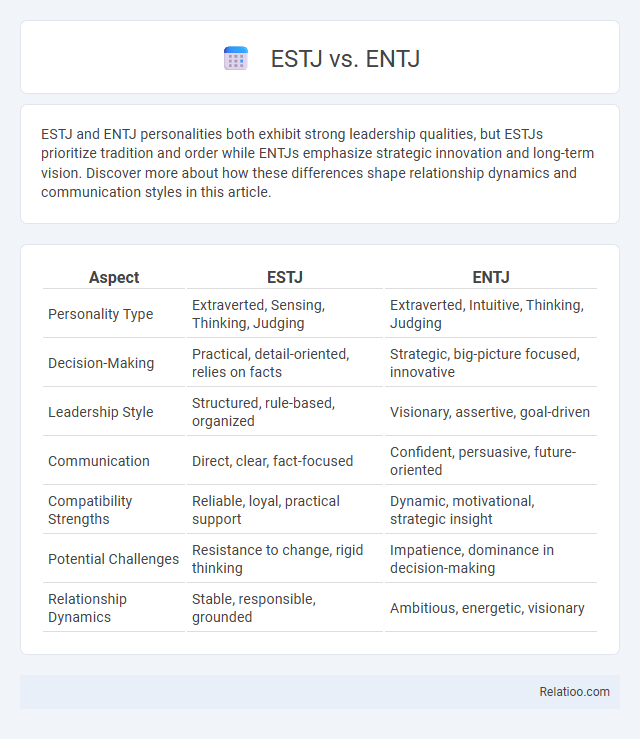ESTJ and ENTJ personalities both exhibit strong leadership qualities, but ESTJs prioritize tradition and order while ENTJs emphasize strategic innovation and long-term vision. Discover more about how these differences shape relationship dynamics and communication styles in this article.
Table of Comparison
| Aspect | ESTJ | ENTJ |
|---|---|---|
| Personality Type | Extraverted, Sensing, Thinking, Judging | Extraverted, Intuitive, Thinking, Judging |
| Decision-Making | Practical, detail-oriented, relies on facts | Strategic, big-picture focused, innovative |
| Leadership Style | Structured, rule-based, organized | Visionary, assertive, goal-driven |
| Communication | Direct, clear, fact-focused | Confident, persuasive, future-oriented |
| Compatibility Strengths | Reliable, loyal, practical support | Dynamic, motivational, strategic insight |
| Potential Challenges | Resistance to change, rigid thinking | Impatience, dominance in decision-making |
| Relationship Dynamics | Stable, responsible, grounded | Ambitious, energetic, visionary |
Overview of ESTJ and ENTJ Personality Types
ESTJ and ENTJ personality types both exhibit strong leadership qualities and a focus on organization and efficiency, with ESTJs embracing tradition and practicality while ENTJs prioritize strategic vision and innovation. Both types share an interest in structure, goal-oriented planning, and decisive action, making them natural leaders in business and management roles. Your understanding of these differences and overlaps helps tailor approaches for maximizing team dynamics and personal growth.
Key Differences Between ESTJ and ENTJ
ESTJs prioritize structured organization and adhere strictly to established rules, while ENTJs focus on strategic innovation and long-term vision, driving change with calculated risk-taking. You will find ESTJs excel in managing day-to-day operations efficiently, whereas ENTJs thrive in leadership roles that require bold decision-making and future planning. Both types share a strong preference for extroversion, thinking, and judging, fostering a natural leadership style and a decisive approach to problem-solving.
Cognitive Functions: ESTJ vs ENTJ
ESTJs primarily use Extraverted Thinking (Te) to organize their environment efficiently, complemented by Introverted Sensing (Si) for relying on past experiences and traditions. ENTJs lead with Extraverted Thinking (Te) as well, but pair it with Introverted Intuition (Ni), enabling them to strategize and envision future possibilities systematically. Both types share strengths in decisiveness and leadership, but ESTJs focus more on concrete facts and procedures, while ENTJs emphasize long-term vision and innovation.
Communication Styles Compared
ESTJs communicate with clear, direct language and prefer organized, structured conversations, emphasizing practical details and facts to ensure efficient decision-making. ENTJs typically exhibit assertive and strategic communication, focusing on big-picture ideas and long-term goals while driving discussions toward leadership and innovation. Both types value clarity and confidence but differ as ESTJs prioritize established procedures and consistency, whereas ENTJs emphasize visionary thinking and adaptability in their communication styles.
Leadership Approaches: ESTJ vs ENTJ
ESTJ leaders excel in organizing and enforcing structure through clear rules and practical processes, ensuring stability and consistency within your team. ENTJ leaders emphasize strategic vision and innovation, driving long-term goals and inspiring growth by challenging norms and embracing change. Both types share a strong focus on leadership efficiency, decisiveness, and achieving results, making them effective in guiding organizations toward success.
Decision-Making Processes
ESTJ and ENTJ personalities both excel in structured decision-making, relying heavily on logic and objective analysis to reach efficient conclusions. Your approach as an ESTJ emphasizes practical, detail-oriented decisions grounded in past experiences, while ENTJs prioritize long-term vision and strategic planning to drive innovation. Shared interests include a commitment to leadership and goal achievement, leveraging decisive judgment to manage teams and projects effectively.
Strengths and Weaknesses
ESTJ and ENTJ personalities both excel in leadership and organization, with ESTJs demonstrating dependable structure and ENTJs showing strategic vision. Your ESTJ strength lies in practical decision-making and reliability, while ENTJs shine through innovation and long-term planning, yet ESTJs may struggle with adaptability and ENTJs with impatience toward differing opinions. Shared interests include a strong drive for achievement and efficiency, but balancing direct communication styles with empathy can help mitigate potential weaknesses in both types.
ESTJ and ENTJ in Relationships
ESTJs excel in relationships through their practical, organized approach and strong commitment to tradition and loyalty, creating stability and clear expectations for their partners. ENTJs bring strategic vision, decisiveness, and passion for growth, often driving both partners toward long-term goals and continuous improvement. Both types share a focus on leadership, efficiency, and direct communication, making their relationships dynamic and goal-oriented.
Career Paths and Workplace Behavior
ESTJs excel in structured environments, thriving in careers like management, law enforcement, and administration due to their strong organizational skills and respect for authority. ENTJs pursue leadership roles in entrepreneurship, strategic planning, and executive management, leveraging their visionary mindset and decisiveness to drive innovation and large-scale projects. Both types share a focus on goal-oriented behavior, efficiency, and leadership, often collaborating effectively in competitive workplaces by combining ESTJ's practical execution with ENTJ's strategic vision.
Tips for Understanding and Working With ESTJ and ENTJ
ESTJs and ENTJs share a dominant Extraverted Thinking (Te) function, making both decisive, organized, and strategic in their approach to problem-solving and leadership. ESTJs thrive on structure, tradition, and clear expectations, while ENTJs prioritize innovation, long-term goals, and efficiency in achieving results. Effective collaboration requires recognizing ESTJs' preference for proven methods and ENTJs' drive for visionary change, communicating clearly to balance practical execution with strategic planning.

Infographic: ESTJ vs ENTJ
 relatioo.com
relatioo.com